BRT+ Webinar Series: Adapting City's Mobility System after Covid-19
Sign-up here for free BRT+ is launching Webinar Series «Adapting City’s Mobility System after Covid-19». The goal is to understand how different cities have adapted their transport systems in face of the Covid-19, studying the case of different cities across the world. Session 1: Active Transport will be broadcasted by Zoom on Wednesday, June 10th […]
Beyond a bus system: Complete streets to revitalize Santiago, Chile
Source: Dario Hidalgo, member of our BRT CoE at TheCityFix
In 2006 Santiago, Chile implemented a public transport reform that reorganized the capital city’s buses into an integrated system with its already successful metro. The well intentioned reform was initially a disaster. Delays, overcrowding, long waits, and unreliable service caused widespread frustration, spurring protests in Chile’s capital. The failures of Transantiago led many to abandon public transport, driving personal vehicles to work instead. As I wrote in 2007, the concept was good but “the devil is in the details.” Santiago had been ambitious, but the new system was poorly designed, ignoring basic good practices for an advanced bus system, such as median stations with advance ticketing and fully dedicated bus lanes.
 Over the next few years, the Chilean government worked hard to fix its mistake – by 2010 the system was rated favorably by users. Delays and overcrowding ceased, but poor reliability, fare evasion and a bad image remained. As a response, the national government announced plans to overhaul of the surface transport using a “complete street” approach to bus corridors throughout Santiago de Chile.
Over the next few years, the Chilean government worked hard to fix its mistake – by 2010 the system was rated favorably by users. Delays and overcrowding ceased, but poor reliability, fare evasion and a bad image remained. As a response, the national government announced plans to overhaul of the surface transport using a “complete street” approach to bus corridors throughout Santiago de Chile.
One of the first corridors to implement new design concepts and participatory planning is Alameda Boulevard, the most emblematic corridor of the city and the country. The boulevard, actually named Avenue Bernardo O´Higgins, honors the leader of the Chilean liberation from Spain 200 years ago. The Chilean government is taking the “complete streets” project very seriously, as a beacon of cutting edge, multimodal integrated transport and urban revitalization.
 This time, they aren’t taking any chances. Along with the newly formed Metropolitan Directorate for Urban Transport (UTPM), Chilean leaders are consulting several parties that were left out of the process in 2006, including several national government agencies and the Greater Santiago municipalities of Lo Prado, Estación Central, Santiago and Providencia.
This time, they aren’t taking any chances. Along with the newly formed Metropolitan Directorate for Urban Transport (UTPM), Chilean leaders are consulting several parties that were left out of the process in 2006, including several national government agencies and the Greater Santiago municipalities of Lo Prado, Estación Central, Santiago and Providencia.
They are also consulting urban planning and public transport experts, that were contacted via our BRT CoE, to make sure they get the “details” right. Urban design experts from Brazil, Chile, Colombia, and Mexico joined Santiago’s authorities in envisioning an urban redevelopment concept for Alameda.
Over several days focused on design, the team developed the concept for an urban project that goes beyond bus operations. Using a “complete street” approach, we envisioned an 11 km (6.9 mi) corridor that will prioritize pedestrians, bicyclists and bus users, and will be better integrated with the existing Metro Line 1. The central park, an important icon for Santiaguinos that has fallen into disrepair, will be rejuvenated; and the historic buildings along the boulevard will receive attention. Good practices for advanced bus systems have also been followed – the plan calls for relocating the bus lanes from the curbside to the median, building stations with prepayment and level boarding, and connecting these stations directly with the underground Metro.
 Improved express services and systems control will enhance the passenger experience. Carolina Tohá, the Mayor of Santiago, knows that this is more than a busway. She explained, “this project can be very beneficial […] it is expected to look at the city in all aspects, not just as a public transport improvement.”
Improved express services and systems control will enhance the passenger experience. Carolina Tohá, the Mayor of Santiago, knows that this is more than a busway. She explained, “this project can be very beneficial […] it is expected to look at the city in all aspects, not just as a public transport improvement.”
The project is expected to be ready in late 2016, and has many challenges to face before its completion. Like many other projects, this visionary new corridor will require political leadership, technical capacity, and adequate funding. When it is finally completed, it will be an example for Latin America and the world, of how a city can go beyond transit to a holistic, accessible, integrated urban space: a “complete Alameda” for the people of Santiago.
The list of experienced public transport consultants shows how serious Santiago is about getting the details right. Among the experts were Pedro Szasz and Paulo Custodio, designers of several bus systems in Latin America, Africa and Asia; Salvador Herrera, Luis Zamorano, Claudio Sarmiento, and myself from Embarq and Embarq Mexico; André Jacobsen from Latin America’s Integrated Systems and BRT Association SIBRT; and Juan Carlos Muñoz, Ricardo Giesen, Rocio Hidalgo, Margarita Greene, Juan Carlos Herrera, and Marco Batarce, professors of engineering and architecture from Pontificia Universidad Católica de Chile and members of our Centre.
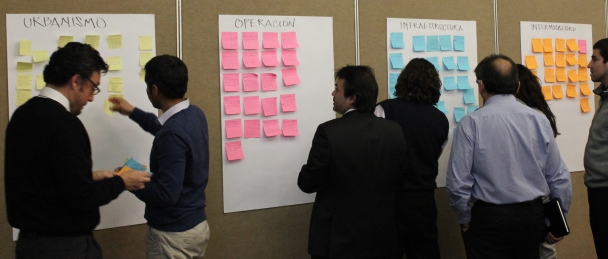 Santiago’s Directorate for Urban Transport, with the support of Pontificia Universidad Católica de Chile, organized the design charrette. With the help of these organizations, we walked and used the buses and the metro in the corridor, looked at the data and previous proposals to understand the issues, and then put our heads together to suggest the best possible urban project for the historic corridor. By involving multiple institutions at the national and local levels and design experts in the early stages of the planning process, Chile is setting itself up for success.
Santiago’s Directorate for Urban Transport, with the support of Pontificia Universidad Católica de Chile, organized the design charrette. With the help of these organizations, we walked and used the buses and the metro in the corridor, looked at the data and previous proposals to understand the issues, and then put our heads together to suggest the best possible urban project for the historic corridor. By involving multiple institutions at the national and local levels and design experts in the early stages of the planning process, Chile is setting itself up for success.
Tweet
Event Wrap Up: General Assembly at TRB13
Our General Assembly this year was held on Tuesday January 15th, at the EMBARQ office at Washington DC. We had a record of audience, with more than 30 participants who had the chance to observe and give feedback to the progress reached by the projects in the Centre. Several advisors were invited to the meeting: Paulo Custodio, Brendan Finn, Gerhard Menckhoff, Shivanand Swamy, Sam Zimmerman, Walter Colombini, and also an important group of key people:
- Suzy Balloussier (Fetranspor)
- Amit Bhatt (EMBARQ India)
- Carlos De Paco (BID)
- Stephan Hassold (University of Auckland)
- Jorge Jara (EMBARQ Andino)
- Yang Jiang (China Sustainable Transport Center)
- Adriana Lobo (CTS Mexico)
- Abel López (CTS México)
- Carlos Mojica (BID)
- Fernando Paez (CTS México)
- Madhav Pai (EMBARQ India)
- Marco Priego (CTS México)
- Pilar Rodríguez (Metrocali)
- José Viegas (International Transport Forum)
- Zhigao Wang (China Sustainable Transport Center)
- Ruishan Zheng (China Sustainable Transport Center)
This is the agenda of the meeting with all the presentations:
| Speaker | Subject |
| Juan Carlos Muñoz | Presentation of the CoE, meeting introduction. Presentation / Video |
| Darío Hidalgo | Observatory: current state and next steps of www.BRTdata.org. Case studies: L4 Metrobus, Transantiago. Presentation / Video |
| Rosário Macário | LS2, Exploring the complexity of policy design: develop a formal structure for retrospective analysis of the various policy components interplaying, and finally a dynamic systems model to search for well-designed and promising policy packages. Presentation / Video |
| Chris Zegras | LS3, From vision to promise to delivery: this project examines two types of pressures that affect the path of BRT from vision to reality: claims from outside and claims from within the existing public transport system. Presentation / Video |
| Abel López | The fragility of the Authority-Operator and Operators-Shareholders: the impact on the sustainabiltily of brt systems. Presentation |
| Toni Lindau | LT1, Development, calibration and validation of bus-following model to support analyses and evaluation of alternative BRT strategies under different scenarios. Presentation / Video |
| Patricia Galilea | LT2, Typology and analysis of business plans, contracts and incentives for BRT and urban mobility systems. Presentation / Video |
| Anson Stewart | LT4, Analysis of successful high-quality bus services in larger developed cities. Presentation / Video |
| Chris Zegras | LT9, Urban design and BRT design to catalyze TOD. Presentation / Video |
| Yang Jiang | BRT-oriented development in China: opportunities and challenges. Presentation |
| Juan Carlos Muñoz | LO1, Explore innovative ways to manage and control BRT services. Presentation / Video |
| Anna Matias | LO5, BRT-TSP: Simulation of Transit Signal Priority Strategies for BRT Corridors. Presentation / Video |
| Dario Hidalgo | Traffic Safety Guidelines. Presentation |
| Luis Gutierrez | SIBRT update. Presentation / Video |
| Juan Carlos Muñoz | Benchmark study and CEDEUS presentation. Presentation 1 Presentation 2 / Video |








¿Comments? ¿Opinions? ¿Similar News? Send them to us!
Tweet
Event wrap up: 12 International Conference on Advanced Systems for Public Transport CASPT12

The twelfth version of the International Conference on Advanced Systems for Public Transport was held in Santiago, Chile from July 23 to July 27, 2012. This time the conference was organized by the Department of Transport Engineering and Logistics of the Pontificia Universidad Católica de Chile, with the support of the Bus Rapid Transit Centre of Excellence. This conference has become the most important in the field of design and operations of public transport systems. For the first time it was organized in the southern hemisphere and in a Latin American city.
For almost 40 years CASPT has served as a forum for the international community of researchers, practitioners and vendors involved on all aspects of public transport planning and operations (with similar emphasis in bus and rail based services). CASPT covers significant contributions to the theory and application of systems and methodologies for advancing public transport planning and operations. CASPT encourages not only the generation and presentation of new ideas, but also hopes to instigate productive collaborations between participants from academia, industry, and government.
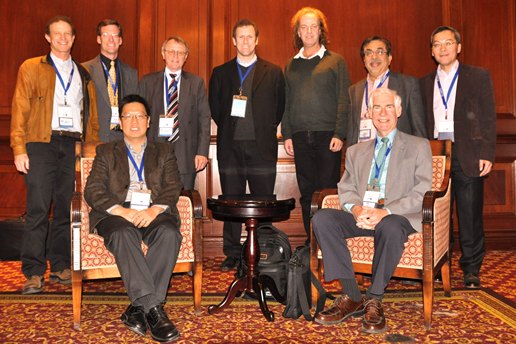 Traditionally, this conference attracts participants from many countries, most of them in North America or Europe. To increase its regional impact in South America, CASPT was organized in parallel to a meeting of the Latin American Association of Integrated Transit Systems and BRT (SIBRT) which guaranteed the participation of members of the most important transit agencies and operators of Latin America.
Traditionally, this conference attracts participants from many countries, most of them in North America or Europe. To increase its regional impact in South America, CASPT was organized in parallel to a meeting of the Latin American Association of Integrated Transit Systems and BRT (SIBRT) which guaranteed the participation of members of the most important transit agencies and operators of Latin America.
The call for extended abstracts received around 180 contributions. They came from over 30 countries from the 5 continents. By the end, 92 papers were presented, plus 7 plenary talks (3 by local authorities at the inauguration) and 15 talks at the SIBRT meetings. The following were the plenary talks:
- Urban Public Transport Policy in Chile – Pedro Pablo Errázuriz, Minister of Transports and Telecommunications of Chile
- Challenges of improving and expanding the Metro in Santiago, Chile – Roberto Bianchi, Chief Executive Officer Metro de Santiago
- Transantiago, a radical transformation: yesterday, today and tomorrow – Patricio Pérez, General Coordinator of Transantiago
- Urban Transport: A little less conversation, a little more action – David A. Hensher, Institute of Transport and Logistics Studies, The University of Sydney, Australia
- On Joint Rail and Property Development: Opportunities and Potential Pitfalls – Hong K. Lo, Hong Kong University of Science and Technology, China
- Traffic congestion in networks, and alleviating it with public transportation and pricing – Carlos Daganzo, University of California, Berkeley, USA
- Sustainable Transportation: Just a question of mode technology election? – Paulo Custodio, Private consultant, Brazil
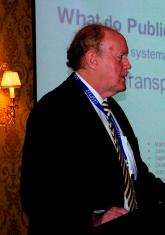


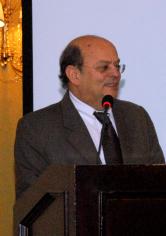
We had a bit over 250 attendants from 33 countries to the meeting (Australia, Brasil, Canada, Chile, China, Colombia, Denmark, Ecuador, Egypt, France, Germany, Hong Kong, Hungary, Iran, Ireland, Israel, Italy, Japan, Mexico, Netherlands, New Zealand, Peru, Portugal, Serbia, South Africa, Spain, Sweden, Switzerland, Taiwan, Turkey, UK, US and Uruguay) during the five days event, which included a Welcome Cocktail, a day trip to Casablanca Valley and Valparaíso, a Conference Dinner at the San Cristóbal hill and Technical visits in Santiago.
Additionally, the opportunity was taken for organizing a fair of software providers for managing, designing and control of public transport systems, as well as an open half-day Workshop between operators, academics, agencies and providers, where the firms had the opportunity to make a presentation about the products and services they offer. We had 7 firms presenting their products and services, and then a roundtable to discuss about them from a Latin American perspective. Around 60 people from firms, agencies, operators and academia attended it.


¿Comments? ¿Opinions? ¿Similar News? Send them to us!
Tweet
Event Wrap Up: Transantiago and Metrobús – How to achieve social sustainability?

Profoundly reforming an urban transportation system is as complicated as trying to rebuild a house with the residents inside. Despite all the shortcomings accompanying the status quo of many urban transportation systems today, both the transportation operators and the users have adapted to the market conditions within which they operate, such that any change must proceed with caution. In other words, grand plans to improve public transportation in our cities must search for a balance between the technically desirable and the politically feasible. Putting all the emphasis on only one side (e.g., the technical) can derail reform, or weaken it to the point where the desired results are not realized. Although certainly not the only ones, two critical aspects to consider in the search for this balance are: the way in which reformers approach negotiations with existing operators; and the way in which they communicate with, and open up to the participation of civil society, more generally. Both aspects influence not only the feasibility of implementing reform but also the sustainability of the system once reformed.
In this context, our Centre of Excellence, together with the Institute of Sociology of the Pontificia Universidad Católica de Chile and MIT’s Department of Urban Studies and Planning convened a diverse group of academics, authorities, operators, and members of civil society to discuss and share lessons from the implementation of Transantiago, in the Chilean capital, and Metrobús, in the Mexican capital. The evento took place on Thursday, 31 May at the Pontificia Universidad Católica de Chile, in Santiago, and was inaugurated by the Chilean Minster of Transportation and Telecommunications, Pedro Pablo Errázuriz.
The design of the event aimed to focus on discussions rather than formal presentations. In the morning, authorities and operators from both cities spoke at a roundtable moderated by Professor Christopher Zegras, from MIT. Private sector participants included: Jesús Padilla, President of Corredor Insurgentes (the principal private operator of the Metrobús system), and Simón Dosque and Hector Moya (Managers of Transantiago’s Buses Vule y Subus Chile, respectively). Authorities included Jorge Rocha, Director of Planning and Evaluation of Metrobús, and Carolina Simonetti, from the General Coordination of Transantiago. Among the noteworthy conclusions from the discussion:
- Success apparently hinges upon moving from a scheme of confrontation (authorities versus entrepreneurs) towards one of collaboration and trust.
- The inclusion of existing operators in the BRT systems is, perhaps, necessary, but implies a complicated process (building consensus within the operators’ organizations themselves and the negotiation of contract terms) that undoubtedly increases project costs.
- These types of projects provide an opportunity to move from an association-based system (of gremios) towards a business-based system. This transition can be painful and generate losers, but it likely reduces negative externalities (accidents, congestion, pollution) and, perhaps, improves service levels for the user.
- The agreements generated with operators for the initial stages of the project should be flexible enough to be adjusted to the changing conditions during implementation.
- It is crucial to strengthen the parties involved (authorities and the private sector) that are committed to successful reform. Within both groups there are heterogeneous interests which the opposition can take advantage of to sabotage the process. In the case of authorities, it is important to avoid, as much as possible, an institutional design within which decision-making remains subdivided among multiple sub-units, as such a scheme fragments vision and responsibilities.

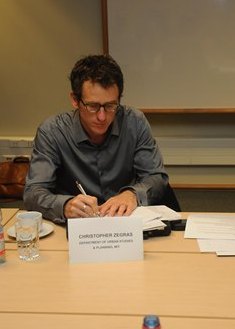


Photos: Andrés Salata
In the afternoon, Professor Manuel Tironi (Instituto de Sociología, PUC) moderated a dialogue titled “How to increase and improve citizen participation in the design and implementation of integrated BRT systems?” Marco Priego (EMBARQ, Mexico) and Sofia Lopez (Ciudad Viva, Santiago) participated as members of NGOs that have emphasized the need to modify certain aspects of the transportation systems in their respective cities. To provide the perspective of the authorities on these topics, the participants included Jorge Rocha on behalf of Metrobús and Germán Correa, ex-General Coordinator of the project that eventually became Transantiago. Among the conclusions from the roundtable:
- Citizen participation should be included, in a sustained manner, in all project stages.
- To speak of “citizen participation” in the abstract is not useful. We should specify the types of participation being considered and desired and clearly distinguish citizen participation (as an interactive political process) from simple marketing and information provision.
- There is a lack of specialists with experience in organizing citizen participation that can strengthen urban transportation system projects and improve prospects for success.
- Knowing citizens’ actual preferences is necessary to better approximate their behavior (e.g., in models); but such knowledge is insufficient for integrating citizens into the processes of design and implementation. We should also (a) better know their daily non-discursive activities and (b) enable them to participate more directly in decision-making.
- The success of citizen participation (and systems better-aligned with users) depends on recognizing the diversity of users and user profiles.
- We should take advantage of the possibilities for real-time interaction with users/citizens enabled by new communication technologies.
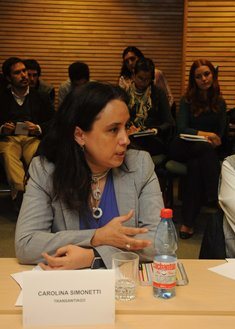

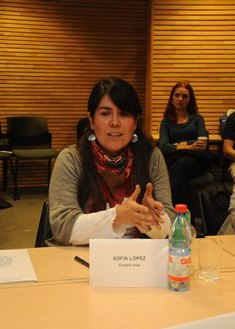

Fotos: Andrés Salata
This workshop was made possible thanks the support of the MIT International Science and Technology Initiatives (MISTI). The material discussed will be analyzed more deeply and serve to further strengthen the research of one of the research groups that participate in the Centre of Excellence ALC-BRT.
Download the full program of the Workshop (in Spanish).
Presentations (in Spanish) by:
Arturo Ardila-Gómez: Transporte y sustentabilidad política.
Christopher Zegras: Metrobús: BRT en Ciudad de México.
Manuel Tironi: Transantiago: Objetivos, Características y Desafíos.

Photo: Andrea Villena
¿Comments? ¿Opinions? ¿Similar News? Send them to us!
Tweet
Graduate studies programs within our Centre of Excellence

We are inviting outstanding and enthusiastic students from all around the world to be part of our Centre of Excellence through research opportunities and internships from our institutions. These are the options available right now:
Pontificia Universidad Católica de Chile (PUC)
At PUC we offer a Master of Science, a Master of Engineering and a PhD program. In all of them students are involved with course work and a research dissertation. A graduate student involved with our Centre of Excellence would devote its dissertation to a problem related with designing, managing, operating or controlling a BRT-based transit system.
In our forthcoming research we expect to improve our understanding of economic aspects as subsidies and taxes; operational aspects as improving commercial speeds, interaction with traffic lights and avoiding bus bunching; demand aspects as route and mode choice modeling and origin destination inference from historic information; network design aspects as express service design and stop location; technological aspects as the use of cell phone information to improve our understanding of bus performance and passenger behavior. We will be offering dissertation topics on these areas to our graduate students in the coming years.
The Department of Transport Engineering and Logistics has eight professors that teach several courses in these and related areas, which can also be complemented by courses offered by other Departments. Scholarships from the Chilean government, the University and our Centre are available, as well as other financing options.
You can find more information in this document.
NEW: Two postdoc positions at PUC Chile. Find the information here.
Institute of Transport and Logistics Studies, The University of Sydney (ITLS Sydney)
The Institute of Transport and Logistics Studies (ITLS) in the Business School at the University of Sydney is a dynamic and high-quality research environment. As Australia’s Key Centre of Excellence in Transport and Logistics Research and Education, celebrating its 16th year in 2011, ITLS is recognised as a centre of excellence within Australia and is ranked among the top five institutes in the world for transport and logistics research and education. Through the establishment of the Key Centre and a memorandum of understanding signed between the University of Sydney and the University of Johannesburg, ITLS is an international collaboration at three nodes: ITLS Sydney, ITS Monash and ITLS Africa.
ITLS offers a number of postgraduate coursework programmes including the Masters of Transport Management. This is designed to provide training in the field of transport with particular emphasis on management and planning. Individual units of study focus on topics including public transport policy and planning, transport economics, and transport policy, all of which are relevant to the understanding of the role of BRT in urban transport. More details, including the wide range of available units of study, are available at this website.
ITLS invites inquires from individuals wanting to pursue higher level research in the area of BRT, whether this is a focus on theoretical or applied research in the area. This would be supported through the strong links between the institutions which comprise the CoE and the interests of Professor Hensher and Professor Mulley in developing understanding in this important area. ITLS has the largest group of postgraduate students in transport and logistics management in Australia and our postgraduate research students have excellent research facilitates and supervision by internationally renowned academic staff. More information is available at this link.
Massachusetts Institute of Technology (MIT)
MIT’s Transportation group has provided leadership in the field of transportation research for many years by emphasizing an interdisciplinary systems approach incorporating engineering, urban planning, transport system management and public policy. We are now applying this interdisciplinary approach to the concept of sustainable transportation to address the critical issues confronting the world today.
The scope of our research has broadened from a focus on the operation of existing systems to include consideration of the interactions of transportation infrastructure and operation, urban spatial structure and land use, economic growth, resource and energy use, and environmental impacts at various spatial and temporal scales. These include issues of public health and environmental impact; the loss of livability of urban areas; the uneven distribution of benefits and costs of transportation projects among different geopolitical areas, social groups and generations; and the consequences of climate change. For more information, visit our Transportation research pages and view videos of MIT transportation researchers talking about their research on MIT World.
Our goal is to contribute to the conceptualization and realization of a system in which people can readily move and effectively transport goods while facilitating economic growth and reducing environmental impacts to sustainable levels. To read about current transportation research projects, please visit the CEE Research Projects website, the Transportation@MIT institute-wide initiative, and the individual faculty websites.
The interdepartmental Master of Science in Transportation (M.S.T.) degree program emphasizes the complexity of transportation and its dependence on the interaction of technology, operations, planning, management and policy-making. Faculty members and research staff from several centers, departments and divisions within MIT are affiliated with the program and serve as research advisors and mentors to M.S.T. students.
The interdepartmental Doctoral Program in Transportation provides a structured and direct follow-on doctoral program for students enrolled in the M.S.T. program or other transportation-related masters degree program at MIT or elsewhere. The interdepartmental structure of the program allows students greater flexibility in developing individual programs of study that cross both disciplinary and departmental lines. The program is administered by the transportation faculty through the director of the interdepartmental doctoral program, who is responsible for admissions, establishment and oversight of program requirements, and conduct of the general examination and thesis defense.
The Master of Engineering transportation track covers the analysis, planning, design, operation and management of transportation systems. It offers a broad range of subjects, including methods for transportation systems analysis, transportation demand analysis, urban transportation planning, transportation and environmental limits, comparative land use and transportation planning, and logistics systems and supply chain management. Also available are subjects focusing on urban public transportation, airlines, airports, intelligent transportation systems (ITS) and marine transportation systems.
Many Master in City Planning (MCP) students from the Dept. of Urban Studies and Planning (DUSP) elect to take one or several transportation-related courses within or outside the DUSP. Also, many MCP students write a thesis related to transportation, conduct transportation-related research, and/or are advised by transportation-related faculty.
Several PhD students from DUSP conduct advanced transportation-related research, working closely with faculty in DUSP and other Departments at MIT. Students tailor their coursework to prepare for the general examinations, which require a first field of study related to the systematic approach of social inquiry (such as urban and regional economics) and a second field related to an area of application (such as transportation and land use).
The MIT Portugal node also counts with education programs in Transportation Systems: Master of Science and Doctoral programs.
Students will work on projects related to ongoing MIT research programs with agencies, industries and government, such as Transport for London, the Massachusetts Bay Transportation Authority, and the Basque Regional Government; ITS, high-speed rail and airport planning for Portugal; and the airline industry.
The interdepartmental Master of Science in Transportation, Doctoral Program in Transportation and Master of Engineering transportation track are administered through the Department of Civil and Environmental Engineering.
¿Comments? ¿Opinions? Send them to us!
Tweet
MIT Transit Leaders Meeting

On June 16-17, 2011 the MIT Transit Research Group hosted the 4th annual MIT Transit Leaders Roundtable in Cambridge, MA.
Photo: Mikel Murga, Juan Carlos Muñoz, Rosário Macário, Fred Salvucci, Nigel Wilson, John Atanucci
The Roundtable brought together 29 executive-level managers from ten large-city transit agencies from Europe and North America: Massachusetts Bay Transportation Authority (MBTA/Boston), Massachusetts (State) Department of Transportation, Transport for London, Régie Autonome des Transports Parisiens (RATP/Paris), Metropolitan Transportation Authority (MTA/New York), Washington Metropolitan Area Transit Authority (WMATA/Washington D.C.), TransLink of Vancouver (B.C., Canada), Metro Transit of Minneapolis-St Paul, Utah Transit Authority (UTA/Salt Lake City), and the Rhode Island Public Transit Authority (RIPTA/Providence). Also participating in the meeting were several faculty, staff and graduate students.
The Roundtable was held at MIT and generated many lively and interesting discussions. The program was structured using an initial “scene-setting” presentation from an academic or agency perspective followed by short agency state-of-the-practice updates and further open discussions.
The major topics discussed included:
How Can Transit Respond to Higher Demand and More Constrained Resources at the Same Time? Charles Monheim, Chief Operating Officer, New York MTA
Strategies for High Quality Bus/BRT in Major Cities Juan Carlos Muñoz and Nigel Wilson PDF presentation
• What strategies have you used, or do you plan to use, to improve bus service quality in terms of:
– Reserved bus lanes and transit signal priority
– Speedier fare collection
– Increased frequency
– Active headway management (hold or express buses, «leapfrog» operations)
– Timed transfers/network connectivity
• What is the evidence on effectiveness of these strategies?
Innovative Partnering to Increase Ridership and Revenue Fred Salvucci PDF presentation
• Business levy to support transit infrastructure investment: London Crossrail case
• Employer-based monthly transit passes
• PPPs for infrastructure delivery and operation
Emerging IT Strategies George Kocur PDF presentation
• Developing system integration capability versus relying on vendors (make versus buy, in some cases), and how knowledgeable should transit organization be in IT, telecom and other technology areas
• Integration with other municipal IT infrastructure: traffic signal priority, emergency incident management, social service benefit programs, employee IDs (possibly used for payment), road operations (snow removal, etc.), and others
• Open standards/open data. Role of open source and developer community; using performance versus technical interface standards in procurements, others
• Legacy modernization. Shifting resources from legacy maintenance to development of new capabilities and cost reduction.
Advanced Customer Information Strategies John Attanucci PDF presentation
• How are you going about improving customer information (pre-trip and real-time)?
• What is your strategy for maximizing the value of AVL/train tracking data in customer information?
• What is your current and expected future reliance on fixed signs (at stops/stations or in retail activity centers) versus wireless devices?
• Should all real-time operations data be made public, and how do you sort the wheat from the chaff of privately- developed phone apps?
Monitoring and Improving Service Reliability Nigel Wilson and Juan Carlos Muñoz PDF presentation
• How do you measure service reliability?
• What service planning and scheduling strategies (e.g., more layover or recovery time, more or fewer timepoints) are you using to improve service reliability? With what degree of success?
• What operations control and management strategies are you using (dispatch/driver interaction, AVL system displays, or messages to drivers) to improve service reliability? With what degree of success?




¿Comments? ¿Opinions? ¿Similar News? Send them to us!
Tweet







